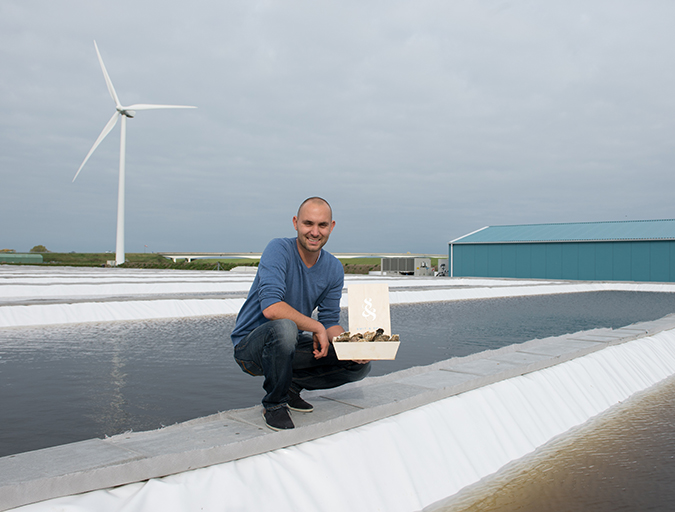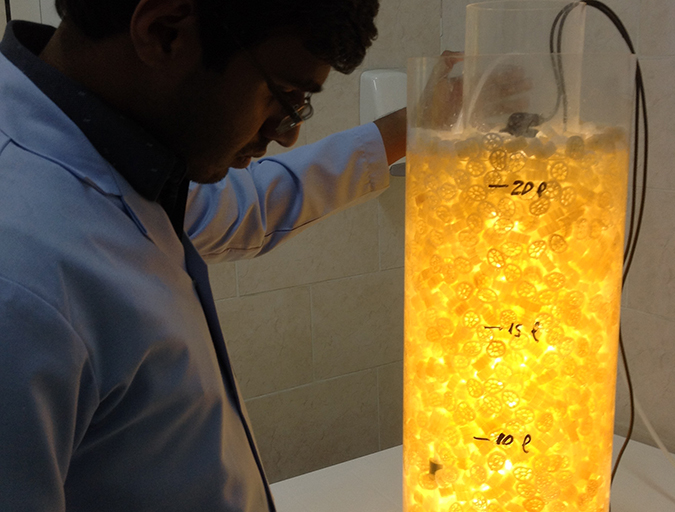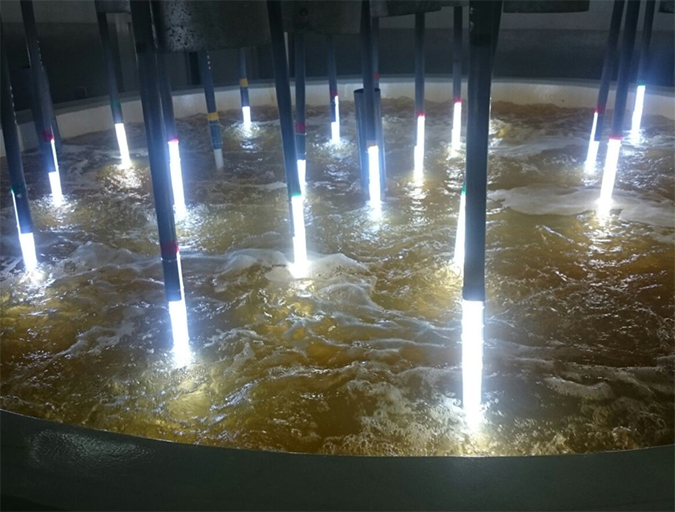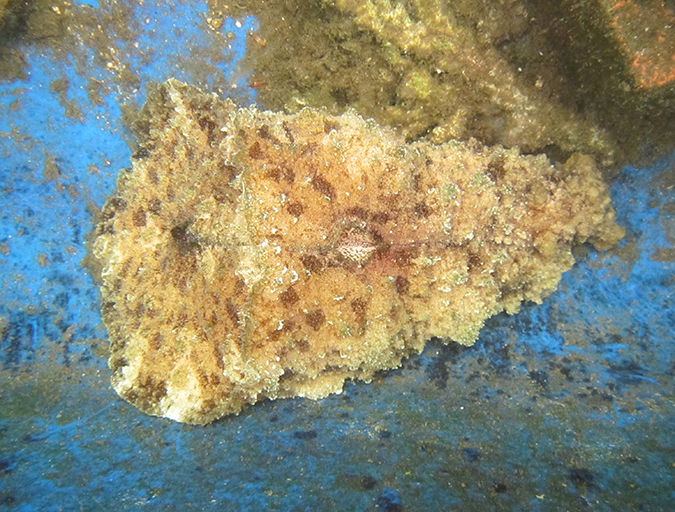A global focus on macroalgae and marine plants will result in many jobs and increased food security

Currently, there is a significant production difference between agriculture and aquaculture (an imbalance of around 100 to 1). Improving this relationship represents a significant challenge to the aquaculture industry. A quantum leap in the scale of global food production is imperative to support increasing food needs on a global scale, as the human population continues to grow along with the additional demand for food. Climate change and its possible impacts on traditional food production practices must also be considered, and mariculture presents a unique opportunity.
Agriculture produces about 10 billion tons annually of various products, most of which are plants. However, it is hard to imagine how this figure can grow much further, considering the toll of this production on diminishing resources of arable land, fertilizers and irrigation water.
Strikingly, aquaculture production is a mere 1 percent of agriculture production, or about 100 million tons per year (according to FAO reports). This is astonishing in a world whose surface is 70 percent water, most of it an oceanic area that receives most of the world’s solar irradiation and that contains huge amounts of nutrients (e.g., 1011 tons of phosphorus), especially in the Pacific Ocean. Desert lands – which cover about a third of the global land surface and also receive significant amounts of solar irradiation, but lack the water and nutrients to become significantly productive – are an additional, slightly used land surface with production potential.
Changing this food production imbalance by increasing aquaculture – and especially mariculture – by 100 times will not result from the current rate of growth of the aquaculture industry, which is around 7 to 8 percent per year. This is because the current starting point of mariculture is only about 60 million tons (fresh weight) per year.
Mariculture production must grow by orders of magnitude to cost-effectively supply all the food we will ever need, and at the same time help support the environment globally and even combat the impact of global warming. This panacea can happen with minimal engineering, by just helping nature do the work sustainably.
Mariculture on a massive scale can be located and developed on the oceans’ surfaces and in coastal deserts, and can use seawater and its intrinsic nutrients. Raising the industry output by two orders of magnitude would require this “new aquaculture” to be very large, yet profitable and beneficial to both the environment and society.
The extractive, photo-autotrophic algae species will lead this growth, just as plants lead agriculture production. While many algae can be cultured, a challenge that remains is the development of engineering concepts for the low-cost production of very large quantities of micro- and macro-algae on the ocean surface and on land. This challenge requires multi-disciplinary research teams with experts on aquaculture, algae culture, ecological/marine engineering, oceanographers, climatologists, economists and other areas of expertise.

Algae culture on a very large scale on the oceans’ surfaces, and with minimal engineering
Artificial enhancement of ocean nutrients using nutrient-rich water upwelling can create surface blooms of phytoplanktonic algae, and promote and support food chains, which will generate large amounts of baitfishes. Based on Dr. John Ryther’s proposition from the 1960s, the Japanese “TAKUMI” Project and the U.S. OTEC Project have been already developing the pumping to the ocean surface of nutrient-rich water using huge pipes – passively or with solar-powered pumps.
Large regions of “ocean deserts” could turn into rich fishing grounds, which could match with their new fisheries the 140 tons/km/year. of the Peruvian and Namibian upwellings. Thus using 10 percent of the global ocean surface could result in fisheries of 5 billion tons/year, and at the same time absorb huge quantities of excessive carbon dioxide (the greenhouse gas CO2).
Algae farms offshore

Macroalgae have been cultured profitably for decades. More than 25 million tons (fresh weight) are produced every year, with an average market value of $400 per ton (dry weight). Most of this production takes place in coastal oceans, and many algae species are excellent food for humans and livestock.
A Japanese proposal by Prof. M. Notoya and co-workers can have macroalgae growing on 100-square-kilometer floating rafts, located away from commercial shipping lanes until ready for harvest and using artificial ocean nutrient enhancement. Each of these giant rafts could possibly produce 106 tons (fresh weight) of macroalgae a year. Matching current global agriculture output with macroalgae will therefore require around 10,000 such rafts and will cover 1,000,000 square kilometers of oceanic area, a mere 0.3 percent of the oceans of the world.
Oceanic IMTA farms offshore
The location of huge integrated multi-trophic aquaculture (IMTA, where one component’s by-products support other components) farms of fed fish cages in open waters, surrounded with filter-feeding bivalve production units – as currently practiced in Atlantic Canada’s Bay of Fundy – will produce large quantities of fish and shellfish.
The effluents, loaded with nutrients, will create a surface plume with high nutrient content, which will imitate an upwelling. A large enough plume will generate a plankton-based food chain and support large amounts of baitfish. Capturing these fishes can at least double the production of the farms, while reducing their environmental impact.

Land-based, very large scale algal culture
Various schemes for very large marine macroalgae farms in coastal deserts have been proposed. The Green Desert Project (GDP), a concept for re-greening the Sahara, through Integrated Aqua-Agro Biotechology (IAAB), is an example. The GDP proposes bringing together a series of technologies to utilize seawater (millions m3/km2/year), gravity-fed directly from the Atlantic to the Sahara’s shebqhas (sub-sea level, dry lakebeds, up to 104 km2 each).
The project proposes to produce simultaneously and sustainably various fishes, crustaceans, molluscs, macroalgae, additional aquatic crops, aquaponics crops, biogas and hydroelectric power. The saline effluent will drain to reservoirs, which will produce “green water” microalgae like Dunaliella sp. that will feed brine shrimp, planktivorous fish, molluscs and birds. The final brine will evaporate at the shebqhas’ bottoms, sequestering salt from the sea (~ 105 tons/km2/year) and humidifying the desert air.
Strikingly, aquaculture production is a mere 1 percent of agriculture production. This is astonishing in a world whose surface is 70 percent water.
This concept above fulfils several basic requisites for the successful, inexpensive production of algae in the Sahara and similar deserts (Garcia Reina 2010; FAO 2010). These requisites include very low-cost seawater pumping, fertilizers (N & P), carbon dioxide (CO2) and inexpensive coastal flatlands in latitudes below 30 degrees-C.
The project proposes to begin with several 20-km2 farms on salty low flatland shebqhas below the sea level and bordering the coasts of Mauritania, Western Sahara, Morocco, Algeria, Tunisia, Libya and Egypt, and in the Arava Valley of Israel and Jordan (as a component of the Red-Dead Seawater Canal funded by the World Bank). The concept is based on local application of integrated multi-trophic aquaculture (IMTA) technology, depending on market considerations, local species and local conditions at each farm. Additional, beneficial side effects include a reduction in the rise in sea levels through the hydration of the desert, and a reduction in the rise of atmospheric CO2.
Perspectives
I hope that this short article convincingly illustrates the possibility of making progress toward matching traditional land-based agriculture’s production with sustainable, maricultured seafood production, using just a small fraction of the global ocean area. This production will be rather innocuous, compared with the potential impacts of doubling agriculture production on land, and will also generate significant employment and other benefits.
Regardless of whether all the options are defined as mariculture, sea ranching or something else, these approaches represent man-made production of seafood on the high seas. Because of the large scale and international law considerations, the involvement of national governments and international organizations is necessary to achieve mariculture’s global potential.
Now that you've reached the end of the article ...
… please consider supporting GSA’s mission to advance responsible seafood practices through education, advocacy and third-party assurances. The Advocate aims to document the evolution of responsible seafood practices and share the expansive knowledge of our vast network of contributors.
By becoming a Global Seafood Alliance member, you’re ensuring that all of the pre-competitive work we do through member benefits, resources and events can continue. Individual membership costs just $50 a year.
Not a GSA member? Join us.
Author
-
Amir Neori, Ph.D.
Senior Researcher
National Center for Mariculture, Israel Oceanographic and Limnological Research
P.O. Box 1212
Eilat 88112, Israel
Related Posts

Intelligence
Dutch shellfish farmers bringing the sea onto land
Bivalve shellfish culture is a low-impact form of protein production, and in many cases is a net-positive for water quality. So why move it indoors? Smit & Smit in the Netherlands has a good argument for doing so.

Aquafeeds
Novel reactor developed for indoor, high-density production of diatoms
The development of this reactor for the indoor cultivation of non-suspended microalgae like important diatoms such as Amphora spp., and the cellular dry matter values produced in this study will help bio-filming science support the development and improvement of in situ feed supplementation for fish and shrimp ponds, particularly in desert environments.

Aquafeeds
Novel light bank reactor aids in microalgae culture
The control of temperature and light intensity in microalgae culture in outdoor tanks is difficult. Progress in algal biotechnology and the use of photo-bioreactors, metabolic engineering and other advances supported development of a novel underwater light bank reactor that allows for more effective light utilization by cultured microalgae.

Responsibility
The odd wedge sea hare is useful as an ‘algae cleaner’
Marine gastropod molluscs known as sea hares are relatively unknown animals that have significant importance in biomedical research due to their particular nervous system. And because of their ability to consume large amounts of algae, they can be very useful in clearwater, marine aquaculture systems.



